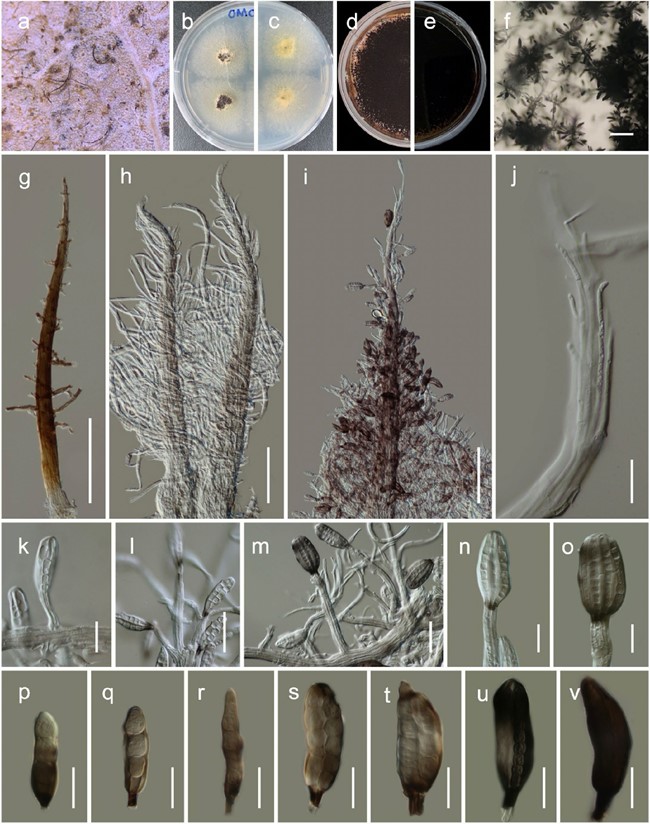Basidiodesertica hydei Maharachch., Wanas. & Al-Sadi, sp. nov.
MycoBank number: MB 837562; Index Fungorum number: IF 837562; Facesoffungi number: FoF 09490; Fig. 19
Etymology. Named in honour of British mycologist K.D. Hyde, for his huge contributions to fungal taxonomy.
Saprobic on dead leaves of unknown plants. Asexual morph: Synnemata arising from stromatic base, erect, cylindrical to subulate, solitary to scattered, brownish 800–1600 × 40–80 µm, widened, foot-like at the base. Conid- iophores macronemeatous, compact and parallel in synnema, 2.5–5 µm diam., flexuous, hyaline to brown, septate, with/ without clamp connections. Conidiogenous cells holoblastic, integrated and terminal, cylindrical, 6–12 × 4–8 µm. Several of a moderate to dark brown, Conidia dictyosporous bulbil- like 50–80 × 20–25 µm ( x̄ = 63.4 × 22.9 µm, n = 30), mul- ticellular, oblong to fusiform, hyaline when young, brown grey to brown violet when mature, with several (4–6) holoblastic conidiogenous cells contributing to development of conidium.
Culture characteristics—Colonies on the PDA slow growing reaching 2 cm diam. in four weeks, irregular, superficial to erumpent, blackish-green to black, lacking aerial mycelium, top surface raised centrally and wrinkled, undulate margin, reverse black.
Material examined—OMAN, Sur, Wadi Shab, from dead leaves of unknown plants, 07.2016, SSN Maharachchikumbura OM 01 (SQU H-124, holotype), ex-type living culture = SQUCC 15289.
GenBank accession numbers: LSU: MW077159; SSU: MW077166; ITS: MW077150.
Notes—Phylogenetically Basidiodesertica hydei shows affinities to the coelomycetous monotypic and saprobic genus Giulia which was typified by G. tenuis (Tassi 1904), and hyphomycetes Tretopileus sphaerophorus (Okada 1998). Giulia tenuis is characterised by dark brown to black conidiomata, hyaline, phialidic, ampulliform to conical, smooth- walled conidiogenous cells and hyaline, cylindrical, aseptate conidia bearing flexuous, unbranched, tubular, apical appendages (Li et al. 2020). Tretopileus sphaerophorus has been reported from Cuba, USA, Sierra Leone, Indonesia and Thailand (Berkeley 1868; Deighton 1960; Weilbacher 1970; Okada 1998). This synnematous hyphomycete produced first a bulbil as a propagule on the top of a synnema and when the bulbil has fallen, the synnema proliferated about seven times to produce new bulbils, each time making conspicuous nodes at the upper part (Okada 1998). Based on phenotype and sequence data, Basidiodesertica is clearly distinct from the members of the Giulia and Tretopileus.

Fig. 19 Basidiodesertica hydei (SQU H-124, holotype). a Synne- mata on natural host surface. b, c Three-day-old culture on PDA (note c reverse). d, e Two-week-old culture on PDA (note e reverse). f Synnemata and conidia on PDA. g–i Synnemata. j Hyphae of synne- mata k–o
